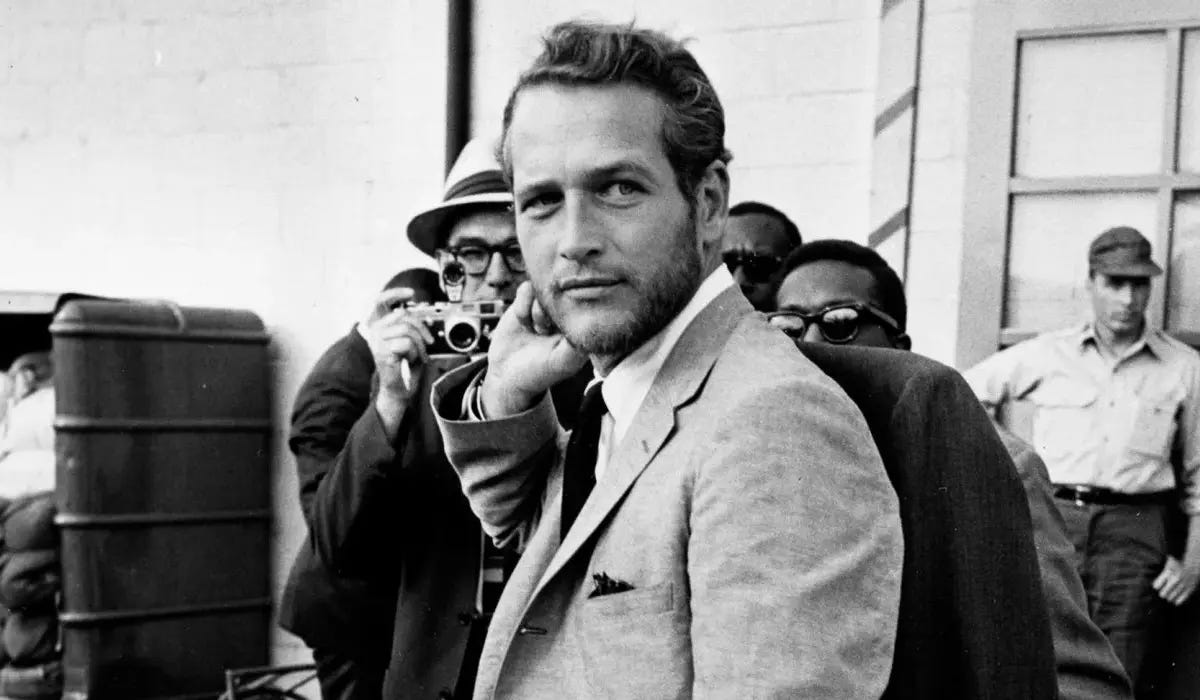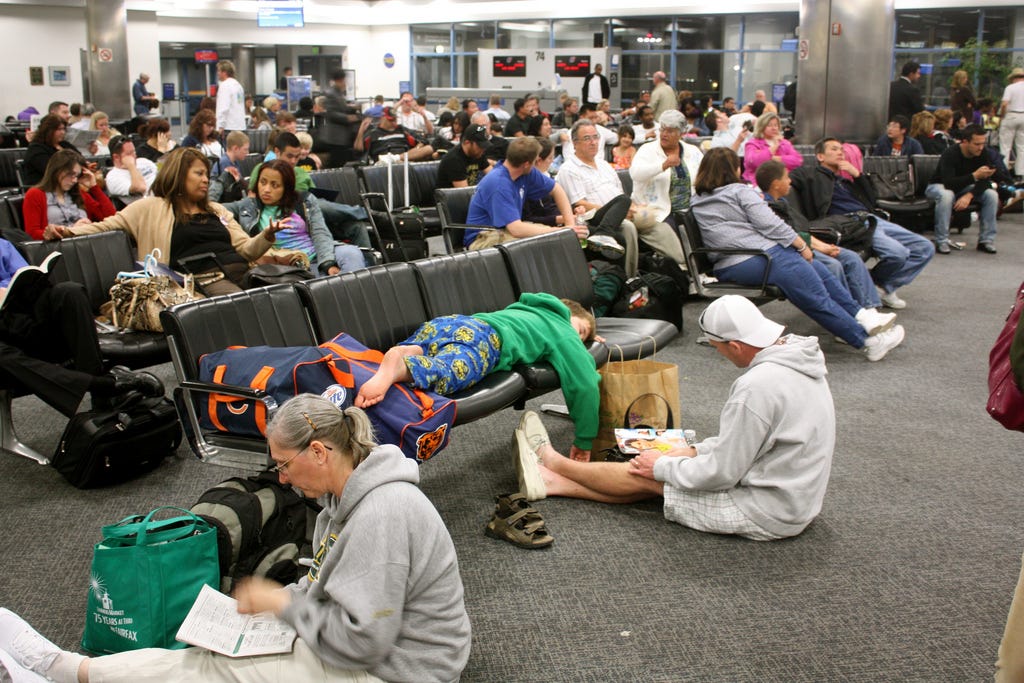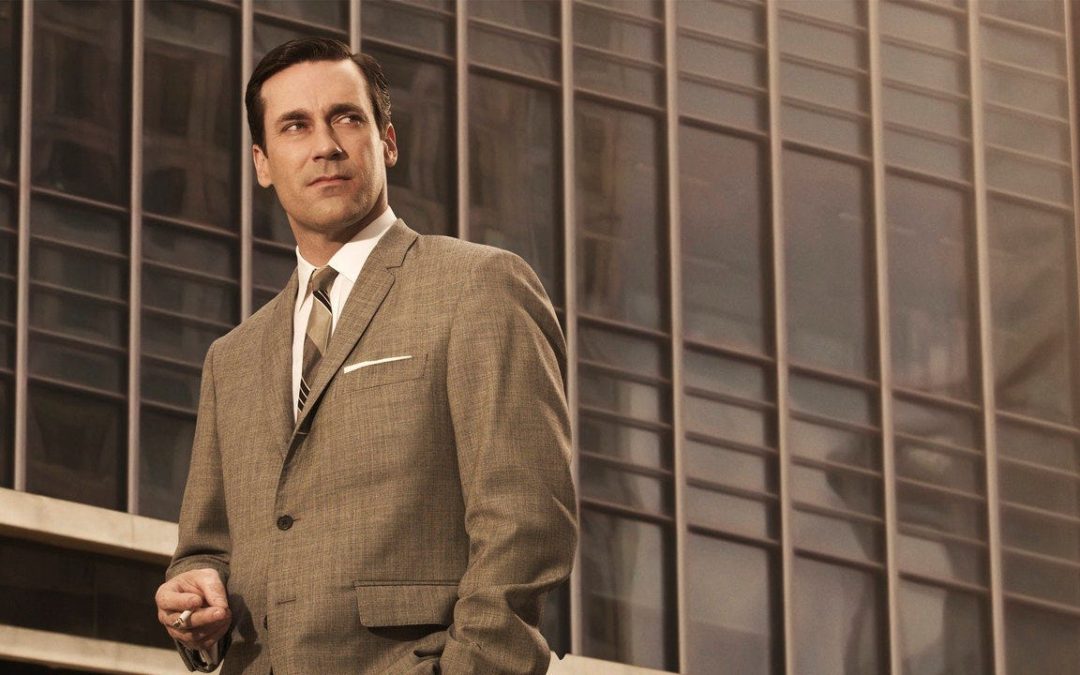
The Good Citizen
Documenting the deliberate dissemination of propaganda and misinformation for control and manipulation of an intentionally dumbed-down population. Not you, of course.
Empire of Elastic Waistbands
Searching for style and substance in the first empire with an audio-visual recorded history of its own collapse.
If by the second paragraph, you sense another black-pilled doomer diatribe manifesting and would prefer your mind be massaged by uplifting and optimistic slants, remember that no effective solution to any social or personal dis-ease was ever discovered by ignoring reality in service of feelings.
The Decay Is Over
On the downward decline of a civilization’s culture, a longing for the past, often viewed through a nostalgic lens can be what Don Draper refers to in one of the most culturally important television episodes to ever air, “Delicate, but potent.”
With a cursory glance at the present, Americans are actively and more frequently looking to the past for answers. Nothing provides a more measurable perspective for which to comprehend the overwhelming dis-ease conferred by the current decrepit state of, well, everything.
During the 2012 Golden Globes, before the Big Equity Commissars of ESG hijacked the corporate advertising industry for woke virtue signaling at the expense of profits, one of the savviest commercials aired. It visually and psychologically encapsulated a shocking socio-cultural downfall.
At that moment Americans got to see a reflection of what they once had through a mirror of a cool, classy, confident, and stylish bygone era only one and a half generations departed. An era they could still see and remember but knew was barely visible in the rearview mirror, based on what stood before them in their now-undersized vanity mirrors.
The product being marketed in the commercial was an automobile, or more specifically—style—though nothing gets sold in America, or anywhere in the world, without a full-fledged psychological shelling of inner and collective voids, this essay notwithstanding.
Chrysler aimed to sell Americans their past, their longing for what they once had, back to them through the new style of their cars.
In the opening sequence, Chrysler launches its first mortar on the American psyche in the form of a question for the American people, “Whatever happened to style?”
Actor Adrien Brody’s voice proclaims, “It wasn’t too long ago. America had it.”
The confusion of regression to the culturally depraved present, now, eleven years after that commercial aired, still hits like a gut punch.
“Where has the glamour gone? It wasn’t too long ago. America had it. Looking, and feeling like a million bucks. It was practically our birthright.”
Delicate, but potent.
Americans weren’t hurried back then, overly stressed while frantically dashing everywhere to keep up with unmanageable lifestyles. They didn’t race anywhere back then proclaims Brody, “We cruised.”
The imagery plays on old Hollywood glamour at the height of American middle-class economic prosperity. The automobile was a symbol of freedom and liberation. Americans cruised the streets and boulevards of cities for fun.
The ad doesn’t use nostalgia so much as ooze nostalgia while exploiting a collective longing for a past people assumed was simply better in every conceivable way.
Americans at home watched that Chrysler commercial during the Golden Globes in 2012, quietly gnashing on Cheez-its and sipping cola, twisting in their Barca loungers to reach for the nearest deep bowl of <insert highly processed junk with seed oils or high fructose corn syrup> the message washing over them as they pondered who will win best supporting actress.
Amnesia eclipses Nostalgia in late-stage empires. While looking to the past for perspective becomes habitual, others prefer forgetting the past, making it easier to cope with all the ugliness and moral confusion of the present.
Late-stage empires tend to have a period of gradual descent, called The Decay, before terminal decline sets everything ablaze, with or without space lasers.
The imperial cycle of history is a model that attempts to document the history of empires or great states. It is used by fiction and fantasy writers to set the backstory and organize the plot. I’ve taken the liberty of adjusting them in some minor places to fit the cycle of American Imperialism and decline. (It begins precisely the year the United States became a global empire.)
- Phase One: Expansion—During this phase, the Empire is still young and rising. These days see the Empire’s rise from military victories, often just one. The Empire racks up massive debts from the warfare, and its economy is left largely unscathed and ready to produce through expansion. It’ll probably be able to pay off its debts over the next few generations. (1945-1960)
- Phase Two: Stabilization—In this phase the conquerors die off and are replaced by administrators who help establish a system of rules and institutions used to manage their empire, overseeing an era of economic & demographic recovery and growth and gradually paying off the still-massive debts of their ancestors, though debts are still accumulating and the payoff never in sight. The greater the debt, the greater the credit. (1960-1990)
- Phase Three: The Decay—The biggest problem facing The Empire is that more and more wealth and power are concentrated in private hands and not those of the state. Those private hands are often chosen by the state and rise above smaller merchants into State Monopolies. New generations of rulers take little pride in the history of the empire. Looting the state becomes an obsession, often wasting state money on expensive military campaigns with no reasonable goals or objectives. The people tend to spend their lives on never-ending consumerism or hedonism, wasting what previous generations left for them instead of trying to secure or multiply it through ‘boring’ things like building infrastructure, re-organizing the taxation system, or establishing new trade missions. (1990-2019)
- Phase Four: The Long Night—The Empire exists in name only at this stage. It is now a failed state. The dissipation of The Empire’s power to rich individuals (oligarchs) is complete, with many families and even regions now only paying lip service to The Empire and its supposed rulers. The Empire must turn its power inward, on managing the perceptions of its subjects so the illusion of its might is maintained in their minds. If it needs to resort to force to keep its subjects in check, it will not hesitate. The Empire’s fiscal situation is in shambles and the state’s debts are compounding with interest payments on the debt no longer manageable. The currency has been debased to lessen the debt load, but it no longer holds value in the eyes of subjects or competing states that are now ascendant. Hedonism and decadence have wrought havoc on the people. Morale is at rock bottom and the people prefer distractive spectacles to waste away their lives. The Oligarchs also prefer the people remain distracted and demoralized as they continue pilfering whatever remains of the Empire’s coffers. (2020-????)
Empires throughout history moved more slowly, hence the final phase known as The Long Night, a reference to George RR Martin’s Game of Thrones where darkness (winter) descends upon the fictional world lasting generations.
Throughout past empires, everything advanced at a snail’s pace compared to today. However as technological innovation accelerates through all industries, the time it takes to transition from one phase to the next, from The Decay to The Long Night is shortened. The Long Night is no longer “long” and can now be measured in years.
Bloggers monitoring the collapsing American Empire have made the same cyclical analogies for decades now. Many still assume, based on the history of other empires that America’s demise will last another few decades. Accounting for the acceleration of events, and speed at which pivotal transformations occur today, it may not last the rest of this decade.
Where it took ancient Rome centuries, it took Portugal, Spain, Holland, and France decades to collapse. England survived a little longer, though by the end of the First World War, it was all but over on paper and they simply had to watch and wait for the full returns to come in from their former colonies.
These empires declined on a scale proportional to the slog of technological advances, the rate of change, and the speed information traveled.
From the Declaration of Independence to when the American Empire finished expanding geographically to its current state, transatlantic travel decreased from a month to hours.
In October 1776 Benjamin Franklin boarded the wooden vessel USS Reprisal to secure treasure and men from the royal court at Versailles, and the buffoonish King Louis XVI. The journey there took over a month.
Sending and communicating information from France to the American colonies took the same amount of time. Even locally, information traveled slowly. Throughout the next two centuries, methods of communication went from letters on laid paper delivered by horseback couriers to telegraphs and telephones, in other words, from weeks or days to seconds.
The most fascinating aspect of what makes the American empire collapse so intriguing is that no empire in history has had its terminal decline documented and displayed back to the people through visual mediums that record it all as it transpires, mainly television, and film.
These unique modern mediums have thoroughly verified the decline of American style and substance, with a full recorded history of the three-piece suited gentlemen, and dress-adorning slender ladies, to the slobification of leisure-wearing obese subjects of the elastic waistband empire.
Over two centuries there was little change. For men ties got wider, then skinnier, with the size of nots and length changing with the trends often set by public figures and movie stars. For ladies dresses got tighter, and skirts shorter, with arms removed altogether, and a shift to jackets and pants breaking all fashion norms. What remained consistent through those decades was substance and style.


As the mirror of the present reflects back the loss of both, these cultural signifiers sound the alarm of terminal decline.




One of the great digital ethnographic hobbies of our time is watching old videos of people walking the streets of an American city in any decade of the 20th century. The most popular observations of commenters beneath all these videos fall into two categories, “Look how skinny people were” and “Look how nicely people dressed.”
Substance and style.
Delicate, but potent.
The Audacity of Leisure Wear
The very first thing one notices when traveling from Budapest, Prague, Berlin, Oslo, Paris, Rome, or Madrid (or any major Middle Eastern or Asian cities) to any airport hub of the American empire is the total decrepit nature of American airports, one or two excepted. The second thing one notices is the size of people lumbering through the terminals. The third thing, and most relevant to the cultural decline is the attire adorning the American people.
The fashion choices confer a people who have surrendered to comfort and excess. They are either incapable of displaying style, having eaten their way above and beyond accessible sizes, or simply given up on life altogether.
Flying in first or business class used to come with dress codes strictly enforced by airlines. Jogging suits, yoga pants, shorts, hoodies, and flip-flops were forbidden. At one point jeans and t-shirts were also forbidden.

Air travel was once a social event, with full-service meals in comfortable seats with plenty of legroom and elbow space. As Americans expanded in girth, the airlines went for broke, shrinking the seats while attempting to squeeze a caloric-storing population into tighter and tighter spaces.
Realizing an unsustainable business model of continuing to offer meals to such hungry people, they switched to sandwiches, and then tiny snacks, and then dispensed with them altogether inviting them to bring bags of greasy shit from fast food outlets in the terminal on board for their fellow passengers to gag and recoil.
At some point this century it became not only socially acceptable to wear pajama-like clothing while clutching those bags of greasy shit, but it also became the preferred attire for celebrities and their post-modern equivalents called influencers.
What exactly have these people “influenced” other than the acceleration of cultural decline?
What does it say about a people who can longer be bothered to put on clothing with buttons or zippers not made from elastic or jersey cotton when heading out in public?
What does it say about a civilization whose preferred footwear is made of rubber and can be washed by a garden hose?
Aspiration and Upward Mobility
The appearance of failure often coincides with the social depreciation of aspiration. In the past, aspiring to a greater social standing required dressing the part. Rampant nihilism and the desire for ease of life and comfort have obliterated aspiration.
The social ladder that was once used to climb upward became a slide in only one direction. As the middle class apexed in numbers, neighbors glanced at neighbors and said, “I’m not as fat as they are yet, and they’re wearing a hoodie and jogging pants, so why can’t I?”
The race to the bottom gathered steam and accelerated toward the making of the slobified majority. Two-thirds of Americans sought to wave the white flag of surrender in regard to substance and style, fitness, and health.
Conformity to decadence and hedonism common in other empires, was transformed into conformity to excesses of consumption and disregard for self, health, and image.
Nobody else is making an effort, why should I bother?
In a sick society that has completely lost its way, it is the duty of the non-conformist to preserve the past, to show those who have given up that they did so by choice, and that it is never too soon to change.
The American empire has made the conservation of its past, the symbol of non-conformity. Conservatives are now the rebels and the revolutionaries.
The non-conformist is fit and healthy, muscular and attractive. The non-conformist dresses fashionably and exerts a cool confident style, often appearing out of place with people glancing at them and wondering, “What’s the occasion?” If the non-conformist could hear their whispers, he would answer unashamedly, “It’s Tuesday, you slobs.” The non-conformist does not paint his hair or dermally defile his body with the permanent scarring of Nihilism’s most grotesque hobby.
The Banality of Tattoos
Less than a century ago tattoos were the exclusive provenance of distant tribes, sailors and biker gangs, or prisoners and other social miscreants willing to sacrifice a little pain to brand their allegiance to whatever group where common cause or brotherhood prevented…
In the decade since that Chrysler commercial aired it’s clear that a loss of style is one of the least significant absences in America today in terms of imposed suffering. Yet nothing is more obvious as a visual cue of cultural decline and signifies the absence of everything else.
It’s not likely to return anytime soon.
A civilization can only afford to worry about style with triumphs, opulence, stability, the rule of law, blind justice, social cohesion, economic liberty, and maximum prosperity for a maximum number of people.
How does a single mother working full time plus two gig jobs to support two kids do so in style?
Style doesn’t require economic riches, and it never did.
The poor and working classes of the past century didn’t give up on aspiring to ascend the economic ladder. They knew they had to first invest in a self-image of self-respect that communicated their desire for ascension.
That they knew it was possible was motivation enough.
Economically wealthy individuals today often dress like slobs, by choice. Having reached a high enough rung on the ladder of upward mobility, they’ve chosen gluttony or comfort over style. While they can afford to wear anything, they often prefer loose-fitting soft fabrics and leisure wear.
Is it a sign of affluence or a signal of indifference and surrender?
I don’t make an effort, because I don’t have to.
With its Empire in terminal decline, its institutions drowning in total corruption and malfeasance, and its laws and systems used to benefit the top tier of society who are actively investing in the demoralization and illness of the masses, a return of style and substance will be impossible until all those forces of destruction are rooted out and terminated.
People have to want to care.
Until then only the strong will survive. They will probably do so with substance and style.
They will be the ones who take care to look after themselves during the final phase of their empire.
They will be the ones with the fitness, energy, and mental fortitude to withstand the onslaught against them.
Surviving the collapse of any empire that turns inward and declares war upon its subjects simply won’t be possible in a 42-inch elastic waistband on sugar high roller coasters, wearing rubber clogs.
And the powers that be know this.



Pushing Maximum Density
There’s thickness and then there’s THICKNESS. Some people are so THICK, their cellulite makes the cover of corporate bikini rags. Other people are so thick they now believe that morbid obesity is beautiful. It’s easier to believe a noble lie that feels good for the …
1. Use your affiliate link for either Healing Support promo or for Heartmend promo.
2. When the customer enters the floralive site (thru your link) they must add EITHER
A. add 3 Healing Support (combination essence) and 3 Blue Eyed Grass to the shopping cart, then go to checkout and enter the coupon code for this promo which is: HSHOLIDAYS (not case sensitive).
This will charge them for the Healing Support and they will get the Blue Eyed Grass free
Or
B. Add 6 Heartmend to shopping cart, go to checkout, there will be a charge for 4 Heartmend and two free when the coupon code HMHOLIDAYS is used.























